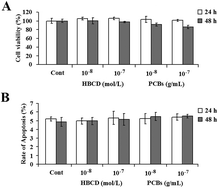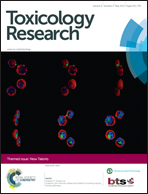HBCD and PCBs enhance the cell migration and invasion of HepG2 via the PI3 K/Akt pathway
Abstract
Exposure to hexabromocyclododecane (HBCD) and polychlorinated biphenyls (PCBs) has been proved to result in diversified toxicity, including cancerogenesis. The objective of this study was to investigate the influence of HBCD and PCBs on the migration and invasion of HepG2 cells, and to explore the potential underlying mechanism. HepG2 cells were treated with different concentrations of HBCD and/or PCBs; cell viability, apoptosis, and cell migration and invasion were then evaluated via cell counting kit-8 (CCK-8) assay, flow cytometry, and cell scratch assay, respectively. The results showed that low concentrations of HBCD or PCBs promoted the migration and invasion of HepG2 cells and enhanced the protein expression level of matrix metalloproteinase 9 (MMP9) and E-cadherin. Further signaling pathway analysis revealed that exposure to HBCD and PCBs significantly increased the phosphorylation level of protein kinase B and extracellular signal-regulated kinase (ERK), and increased expression of the mammalian target of rapamycin (mTOR) in the phosphatidylinositol 3-kinase/protein kinase B (PI3 K/Akt) pathway. The PI3 K/Akt inhibitors LY294002 and MK-2206 attenuated the effects of HBCD and PCBs on cell migration and invasion. Overall, these results indicate that low concentrations of HBCD and PCBs can enhance the migration and invasion ability in HepG2 cells through activation of the PI3 K/Akt signaling pathway.

- This article is part of the themed collection: New Talents

 Please wait while we load your content...
Please wait while we load your content...